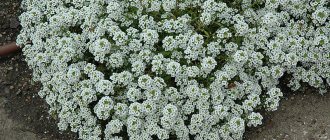Category: Siderates Reading time: 9 min · Views: 3,054
Many people are familiar with these flowers with a star-shaped rosette of leaves, in the center of which a drop of morning dew shines so beautifully, and a columnar panicle of blue or bright purple inflorescences. Lupine as a green manure, and all its types - annual, perennial, white or narrow-leaved - are an excellent means of fertilizing the land.
There are many varieties of green manure. But lupine stands apart from them, primarily because it is beautiful. The area sown with it looks like a specially cultivated flower garden. Whereas in fact, the role of lupine when sowing it is simply to enrich the soil with those fertilizers and microelements that were “eaten” from it by previous plantings. That is, do the work that all types of green manure do - enrich the soil with nutrients.
Types of lupins
Blue lupine as green manure
It has a straight stem and the same root with a few lateral shoots. It is called blue from the wild, basic breed, from which varieties with purple, lilac, blue and pink flowers were subsequently bred.
Breeders have developed many varieties of this plant: “Crystal”, “Nemchinovsky Blue”, “Smena”, etc., which can be used both for enriching and loosening the soil, and as fodder. But there is a special variety that is used to sow areas intended for future crops, which plays the role of green manure. And it is called simply, to immediately indicate its purpose: “Siderat-38”.
The method of propagation of lupine is interesting: ripe pods burst, instantly twisting their halves, and shoot seeds 2-4 meters in different directions. This achieves even coverage of the areas for propagation, thus giving a second harvest per season. But gardeners should not use this method because of the uncontrollability of scattering seeds in the wrong place. It is easier to mow the tops before they are fully ripe.
Blue angustifolia, with its small above-ground part (the plant rarely exceeds one and a half meters), has phenomenal roots, reaching 2 meters. And if you take into account their ability to move apart dense soils, it becomes clear why blue lupine is preferred as a green manure. You just need to wait a year, sowing it in the spring and plowing the area with grass in the fall. Over the winter, the roots in the ground will die and partially decompose, enriching the soil with substances useful for future crops.
Yellow lupine
An even shorter plant than the blue one, reaching a length of barely 1 meter. The only one of the annual lupins whose method of reproduction is cross-pollination, unlike white and blue ones - they can self-pollinate.
It has “candle” inflorescences of soft yellow, sometimes with an orange tint. The crop is heat-loving, so in the middle zone it can be sown only when stable spring warmth sets in, excluding night frosts.
White varieties are sown: “Fakel”, “Peresvet” and “Grodnensky-3”, on sandstones and sandy loams, in which the quality of yellow lupine is well demonstrated, such as binding loose soils with tiny and very branched small feeding roots.
White
White lupine is rarely used as green manure. It is sown mainly as a fodder crop for livestock.
The main benefit why white lupine is preferred as a fodder crop is the absence of alkaloids in the stems, leaves and seeds that are harmful to animals. In blue and yellow lupine they are present initially - that is why the wireworm hastily leaves the plantation with them, which dies from these alkaloids.
It requires care, unlike its yellow and blue lupins, but it will more than pay off in the productivity of the plant. White lupine reaches a height of 2 meters, and the “candles” of inflorescences themselves are 30 centimeters long. All parts of the plant are edible for livestock, and the root, left in the ground until next year, having decomposed, will enrich the soil with minerals and organic matter no worse than other green manures. Only the above-ground part, naturally, will not be used for this purpose.
Benefits of lupine
- The ability of lupins to penetrate deeply (up to 1.5-2 meters) with their roots deep into the earth, even beyond the boundaries of the cultivated soil layer, makes it a kind of “pump” that lifts monohydrogen phosphates to the top. And since the plant itself does not consume them, but only accumulates them in its roots and other parts, then next year these minerals will become available to subsequent crops.
- In addition to the delivery and accumulation of mineral and organic substances after their life cycle, lupine roots, by loosening the soil, enrich it with oxygen, destroying anaerobic microflora.
- Alkaloids, of which there are many in blue and yellow lupine, and especially such as lupinin, will not only repel pests and destroy pathogenic forms of fungi and bacteria, but also, when disintegrating, will significantly reduce the acidity of the soil, making it either neutral or slightly alkaline.
- Quickly gains green mass (especially white, with proper cultivation). After just a month and a half, you can carry out the first mowing of the white variety for animal feed. If the entire mass of the plant is used as green manure, this will replace the application of mineral fertilizers and organic matter, and the soil structure will be closer to ideal for any crops.
- Does not require serious care - except for watering during dry periods. In terms of viability it is close to the most tenacious weeds.
What crops are sowing recommended for?
Lupine belongs to the legume family. It is not recommended to sow it in front of representatives of the same family, as well as in front of cruciferous plants:
- cabbage;
- radish;
- rapeseed;
- beans;
- peas;
- beans.
Lupine gets along well with all other crops, increasing their productivity and enriching the soil with its tops. Experienced farmers advise planting green manure before:
- pepper;
- cucumbers;
- tomatoes;
- cereals;
- strawberries and garden strawberries.
How to sow
In a “wild” area where nothing grew before, the first thing you need to do is remove the weeds. A disc cultivator is quite suitable for this; it will loosen the top layer of soil, destroying the root system of the weeds dormant in it. After this, all available plant residues are removed, and usually in the second half of May, when the risk of night freezing of the soil disappears, sowing is done.
The seeds need to be buried approximately 3-4 cm in narrow furrows, in moist soil: if the weather has been dry for a long time, it is pre-irrigated. Watering is also done one day after sowing. The total amount of water poured onto the area with lupine sowing should be one and a half times greater than the total mass of seeds. The average distance between seeds introduced into the ground should be maintained in the range from 5 to 10 cm.
Lupine seeds are quite large, so those who have time sometimes help this crop to germinate by first slightly cutting each seed. This will not harm the quality of the seedlings, and germination itself will occur faster.
For better germination, seeds can be soaked for a day, the day immediately preceding sowing.
Landing rules
Let us dwell in more detail on the agricultural technology of planting and growing lupine as a green manure plant.
Choice of time and place
Before planting seedlings, the soil must be dug up to the depth of a spade bayonet and be sure to be leveled. As for fertilizing, at the very initial stage, even when the soil is quite poor, you should not apply either organic or any other nitrogen or complex compounds. The fact is that nitrogen-fixing bacteria immediately after the start of growth of one-year-old lupine rapidly develop on their own, and excess nitrogen will only slow down this process.
Landing
The technology for planting lupine is quite simple. The only thing that is required from the owner of the site is to thoroughly dig and level it. After this, it is necessary to make grooves, deepening them by 3-5 cm, the distance between them should be 20-25 cm wide. The seedlings are placed in them so that approximately 10-12 cm of soil remains between them. The standard consumption of annual lupine seedlings per hectare of land is usually about 3 kg, although if the seeding material is too small, fewer seeds may be required.
If the seed material has been stored for 12 months or more, or in the case when you do not know the exact time of its storage, it is best to scarify the seeds so that they germinate as quickly as possible. To do this, the shell of each family is slightly damaged.
This may seem quite simple, but in practice it is not, since the lupine seed coat is very hard. Surely, experienced gardeners have seen more than once how young shoots that had broken out to the surface of the soil could not free themselves from their cotyledon. That is why during the scarification process you need to be very careful and not get hurt yourself.
As a rule, in order to speed up the process of seed germination, 2-3 light cuts with a sharp scalpel are enough; alternatively, you can lightly treat the seedlings with the finest sandpaper.
Care
Lupine does not require any special care. 3-5 days after planting in the ground, it is necessary to harrow with a rake or light harrow. And if you are dealing with soil with a low sand content, then harrowing should be done only after the plants have formed 4-5 full leaves. It is best to do this after 16 hours.
Plants need to be watered only if a dry crust appears on the surface of the earth; if desired, you can add biological products with active microorganisms.
Cleaning time
If you intend to plant lupine as green manure, then you need to mow it before the onset of mass flowering. In most cases, some gardeners dig up the beds, but this is not at all necessary - it is quite enough to simply mow the green mass, cut off the roots and sprinkle everything on top with soil. If the weather continues to be dry and hot, the beds should be watered additionally. The microorganisms will do all the further work for you.
The effect of lupins on the soil
On thin roots extending from the main, skeletal root, during the growth of lupine, small nodules are formed - accumulators of nitrogenous substances. As a result of this accumulation, aspartic acid is synthesized, as well as other similar types of nitrogen-containing amino acids.
Nitrogen is almost the most important component that allows all plants to gain green mass. But being unbound, it quickly evaporates from the soil, depleting it. Therefore, the use of green manure plants such as lupine is often the only and inexpensive way out of the situation when the soils are poor in fertilizers and microelements.
The herbaceous part of lupine, plowed into the ground in the fall, is close to manure in terms of the content of nitrogen, phosphorus and potassium compounds - but with much better and easier digestibility than the latter.
Comparison with other green manures
| Type of green manure | Productivity by green mass (ts/ha) | How many days will it take to reach maximum productivity? | Amount of nitrogen in biomass | The amount of phosphorus oxides in biomass | Potassium oxides in biomass |
| Lupine | 526 | 80 | 231 | 63 | 209 |
| Peas | 219 | 80 | 117 | 71 | 215 |
| Vika | 257 | 90 | 160 | 73 | 201 |
| Phacelia | 317 | 60 | 78 | 52 | 196 |
| Beans | 157 | 80 | 58 | 24 | 248 |
| Oilseed radish | 462 | 50 | 86 | 66 | 59 |
So lupine has a lot of advantages over other green manures. In addition to the above, this is also the possibility of planting on areas that have never been cultivated before, and a better ability to fix nitrogen in compounds that are convenient for absorption. With a successful combination of circumstances, lupine can bind up to 160 kg of nitrogen from the atmosphere, which will give the same effect to 500 kilograms of ammonium nitrate.
For its development, lupine itself does not require any fertilizers; you can plow in its green mass after mowing just a month and a half after sowing, and for germination you do not need to bother with such a thing as seedlings. Not to mention its unpretentiousness to summer weather conditions and its high decorative value.
Due to its extensive and long root system, lupine literally tears apart dense lumps that have been compacted in the depths of the earth for decades or even centuries, crushing them with slow pressure. Nematodes, wireworms and such unpleasant neighbors of root systems as chafers are in a hurry to get out of the area in which lupins were sown - the alkaloids released into the environment successfully expel pests from the soil.
These alkaloids also inhibit weeds, the growth of which stops, and overly acidified soil under the influence of these same alkaloids is neutralized to slightly alkaline.
Does not contain, unlike pure or even fermented manure or bird droppings, pathogenic microflora or larvae of harmful insects.
When to sow
Sowing of lupine is most often carried out in the spring - not earlier than the end of April . In cold regions, later dates are recommended - from mid-May. The main condition is the absence of late frosts. It must be taken into account that the crop grows quite slowly and is mowed almost two months after germination. During this time, the plant will have time to bloom. The appearance of green pods is a signal that the green manure is ready for mowing.
In summer, lupine is sown at the end of August . This is the optimal time - before the first frost, the plant will have time to sprout vigorously and grow a sufficient amount of green mass.
Since lupine does not differ in growth rate, it is not sown in the fall for green manure . The exception is perennial crop species. They can be sowed throughout the entire season, but only in free areas, since the greens will only have to be mowed next year.
Lupine care
It does not require special care, and easily develops even the most neglected and virgin areas - as long as the soil is normal, not poisoned by industrial emissions.
For better development of the underground part of the plant, which will ensure high quality soil for the next year, after sowing it is necessary to mow the grown lupine stems along with the pods within 1.5 - 2 months.
There is no need to dig the cut stems into the ground. It is enough just to lightly sprinkle the mown tops with soil, and fermentation processes will quickly help to decompose the green mass of the stems into its components, enriching the top layer of soil. You just need to remember to cut off the roots with a flat cutter, which is used instead of a plow to protect soils from erosion.
But it happens that for some reason the one who sowed the lupine could not cut it on time. Then the overgrown stems need to be cut off for compost, taking them out of the field. The fact is that woody lupine trunks do not decompose completely, and in the spring they will serve as an obstacle to tillage.
Interaction with other plants
If lupine is chosen as a green manure, there is no point in using other plants with similar properties. Instead of supplementing, they can mutually extinguish their beneficial properties, and the plants will begin to fight for resources.
Another thing is to sow between rows; under these conditions, their roots will serve as a kind of pump, pumping out nutrients from the deep layers of the soil that the cultivated plants simply cannot reach. All types of lupine can be used for this, although white, with its more branched roots, is preferable. The main thing is to water green manure on time; in hot weather they are very critical to lack of moisture.
All nightshades (eggplant, potatoes, tomatoes), peppers, representatives of cruciferous vegetables (all cabbage, turnips, radishes, turnips), and herbaceous berries (strawberries and wild strawberries) feel good next to lupine. But lupine needs to be removed from its proximity to legumes, which themselves are green manure.
Why cultivation may fail
Primarily due to the high alkalinity of the soil. Producing alkaloids that transform acidic soils into neutral or alkaline, it itself, in turn, requires an acidic environment for successful germination.
Many of those who first sowed lupine as green manure are frightened by the abundance of weeds that sprout along with it. They fear that the weed will overwhelm this crop. But these fears are in vain. Once he takes root properly, he will not leave his neighbors a single chance to survive!
Everything is used: its deep roots, robbing neighbors of nutrients, secreted alkaloids, darkening with its crowns other slower-growing plants.
And if lupine is sown in fields previously occupied by rye or wheat, that’s generally great: these cereals are famous for successfully suppressing any weeds (except cornflower)
Reviews from gardeners and gardeners
The best green manure for clay and loamy soils is the narrow-leaved lupine variety Siderat 38, bred by the All-Russian Scientific Research Institute of Lupine. After a couple of seasons of planting and plowing, the clay soil turns black. In addition, it is not as tall as other varieties.
Yes, the lupine has taken over all our fields! BEAUTIFUL! And how funny it is that it shoots its seeds away from itself, when the halves of the pods open, they curl up into a spiral instantly and the seeds scatter in different directions, that’s how it captures territory. I collected the seeds and tried to sow them like green manure in the garden - it sprouts very slowly and poorly, the weeds grow much faster, so I gave up this idea with lupine.
We have lupins growing near the gate, my wife doesn’t like them because of their aggressiveness, but I, on the contrary, like them, they bloom beautifully, rarely get sick, they are green from early spring to late autumn, now they are very similar to mini palm trees, a kind of ikebana . And you can fight against their aggressiveness: after the fruit has set, cut off the inflorescences, after a week the flowers will appear again, which after the fruit has set, cut off again, etc. Thus, the flowering of lupins is extended by at least a month.
Lupine as a green manure has long proven itself to be the best. And do not be afraid of stories about its ability to multiply and spread rapidly and irrevocably. Of course, perennial lupine is capable of this, but by taking annual varieties into your service, you can avoid this problem and give your land the opportunity to rest and replenish its supply of nutrients. And at the same time admire the beautiful lupine blossoms.











